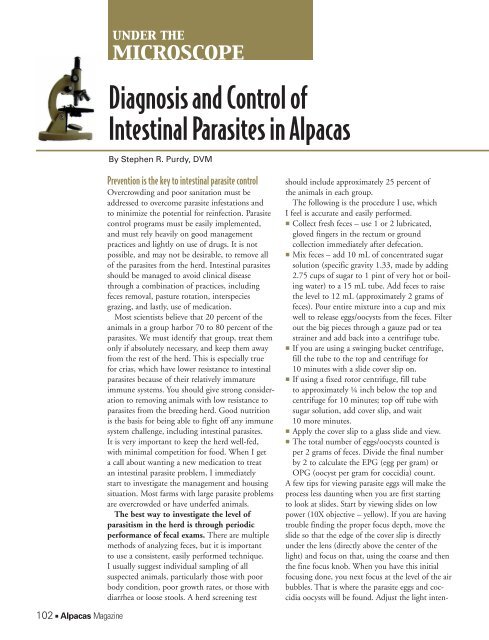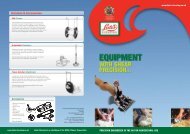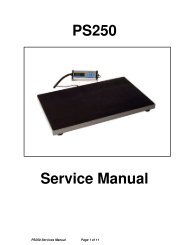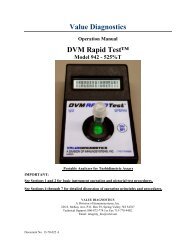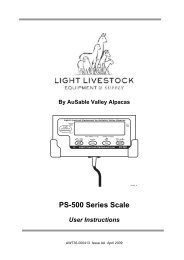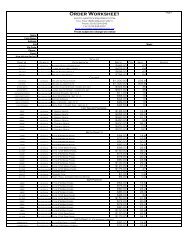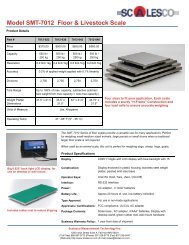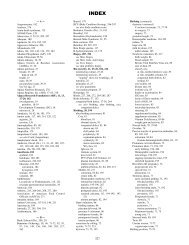Diagnosis and Control of Intestinal Parasites in Alpacas
Diagnosis and Control of Intestinal Parasites in Alpacas
Diagnosis and Control of Intestinal Parasites in Alpacas
You also want an ePaper? Increase the reach of your titles
YUMPU automatically turns print PDFs into web optimized ePapers that Google loves.
under themicroscope<strong>Diagnosis</strong> <strong>and</strong> <strong>Control</strong> <strong>of</strong><strong>Intest<strong>in</strong>al</strong> <strong>Parasites</strong> <strong>in</strong> <strong>Alpacas</strong>By Stephen R. Purdy, DVMPrevention is the key to <strong>in</strong>test<strong>in</strong>al parasite controlOvercrowd<strong>in</strong>g <strong>and</strong> poor sanitation must beaddressed to overcome parasite <strong>in</strong>festations <strong>and</strong>to m<strong>in</strong>imize the potential for re<strong>in</strong>fection. Parasitecontrol programs must be easily implemented,<strong>and</strong> must rely heavily on good managementpractices <strong>and</strong> lightly on use <strong>of</strong> drugs. It is notpossible, <strong>and</strong> may not be desirable, to remove all<strong>of</strong> the parasites from the herd. <strong>Intest<strong>in</strong>al</strong> parasitesshould be managed to avoid cl<strong>in</strong>ical diseasethrough a comb<strong>in</strong>ation <strong>of</strong> practices, <strong>in</strong>clud<strong>in</strong>gfeces removal, pasture rotation, <strong>in</strong>terspeciesgraz<strong>in</strong>g, <strong>and</strong> lastly, use <strong>of</strong> medication.Most scientists believe that 20 percent <strong>of</strong> theanimals <strong>in</strong> a group harbor 70 to 80 percent <strong>of</strong> theparasites. We must identify that group, treat themonly if absolutely necessary, <strong>and</strong> keep them awayfrom the rest <strong>of</strong> the herd. This is especially truefor crias, which have lower resistance to <strong>in</strong>test<strong>in</strong>alparasites because <strong>of</strong> their relatively immatureimmune systems. You should give strong considerationto remov<strong>in</strong>g animals with low resistance toparasites from the breed<strong>in</strong>g herd. Good nutritionis the basis for be<strong>in</strong>g able to fight <strong>of</strong>f any immunesystem challenge, <strong>in</strong>clud<strong>in</strong>g <strong>in</strong>test<strong>in</strong>al parasites.It is very important to keep the herd well-fed,with m<strong>in</strong>imal competition for food. When I geta call about want<strong>in</strong>g a new medication to treatan <strong>in</strong>test<strong>in</strong>al parasite problem, I immediatelystart to <strong>in</strong>vestigate the management <strong>and</strong> hous<strong>in</strong>gsituation. Most farms with large parasite problemsare overcrowded or have underfed animals.The best way to <strong>in</strong>vestigate the level <strong>of</strong>parasitism <strong>in</strong> the herd is through periodicperformance <strong>of</strong> fecal exams. There are multiplemethods <strong>of</strong> analyz<strong>in</strong>g feces, but it is importantto use a consistent, easily performed technique.I usually suggest <strong>in</strong>dividual sampl<strong>in</strong>g <strong>of</strong> allsuspected animals, particularly those with poorbody condition, poor growth rates, or those withdiarrhea or loose stools. A herd screen<strong>in</strong>g testshould <strong>in</strong>clude approximately 25 percent <strong>of</strong>the animals <strong>in</strong> each group.The follow<strong>in</strong>g is the procedure I use, whichI feel is accurate <strong>and</strong> easily performed.• Collect fresh feces – use 1 or 2 lubricated,gloved f<strong>in</strong>gers <strong>in</strong> the rectum or groundcollection immediately after defecation.• Mix feces – add 10 mL <strong>of</strong> concentrated sugarsolution (specific gravity 1.33, made by add<strong>in</strong>g2.75 cups <strong>of</strong> sugar to 1 p<strong>in</strong>t <strong>of</strong> very hot or boil<strong>in</strong>gwater) to a 15 mL tube. Add feces to raisethe level to 12 mL (approximately 2 grams <strong>of</strong>feces). Pour entire mixture <strong>in</strong>to a cup <strong>and</strong> mixwell to release eggs/oocysts from the feces. Filterout the big pieces through a gauze pad or teastra<strong>in</strong>er <strong>and</strong> add back <strong>in</strong>to a centrifuge tube.• If you are us<strong>in</strong>g a sw<strong>in</strong>g<strong>in</strong>g bucket centrifuge,fill the tube to the top <strong>and</strong> centrifuge for10 m<strong>in</strong>utes with a slide cover slip on.• If us<strong>in</strong>g a fixed rotor centrifuge, fill tubeto approximately ¼ <strong>in</strong>ch below the top <strong>and</strong>centrifuge for 10 m<strong>in</strong>utes; top <strong>of</strong>f tube withsugar solution, add cover slip, <strong>and</strong> wait10 more m<strong>in</strong>utes.• Apply the cover slip to a glass slide <strong>and</strong> view.• The total number <strong>of</strong> eggs/oocysts counted isper 2 grams <strong>of</strong> feces. Divide the f<strong>in</strong>al numberby 2 to calculate the EPG (egg per gram) orOPG (oocyst per gram for coccidia) count.A few tips for view<strong>in</strong>g parasite eggs will make theprocess less daunt<strong>in</strong>g when you are first start<strong>in</strong>gto look at slides. Start by view<strong>in</strong>g slides on lowpower (10X objective – yellow). If you are hav<strong>in</strong>gtrouble f<strong>in</strong>d<strong>in</strong>g the proper focus depth, move theslide so that the edge <strong>of</strong> the cover slip is directlyunder the lens (directly above the center <strong>of</strong> thelight) <strong>and</strong> focus on that, us<strong>in</strong>g the coarse <strong>and</strong> thenthe f<strong>in</strong>e focus knob. When you have this <strong>in</strong>itialfocus<strong>in</strong>g done, you next focus at the level <strong>of</strong> the airbubbles. That is where the parasite eggs <strong>and</strong> coccidiaoocysts will be found. Adjust the light <strong>in</strong>ten-102 • <strong>Alpacas</strong> Magaz<strong>in</strong>e
sity so that you can easily see the slide withoutbe<strong>in</strong>g bl<strong>in</strong>ded or without peer<strong>in</strong>g <strong>in</strong>to the darkness.Do not get discouraged at first – everyone needs topractice to learn this. Repetition is the key here.A few words on parasite term<strong>in</strong>ology will helpto alleviate confusion. These are generally acceptedterms used by veter<strong>in</strong>ary parasitologists.• Nematode – roundworm, non-segmented;microscopic:• Strongyles – eggs all look the same, canbe differentiated by grow<strong>in</strong>g larvae butnot usually done• Nematodirus – largest egg; dist<strong>in</strong>ctive “shell”;can survive on pasture over w<strong>in</strong>ter to hatch<strong>in</strong> the spr<strong>in</strong>g• Whipworms (Trichuris) – oval eggs with“doors” on the ends• Cestode: tapeworm:• Monezia; eggs <strong>of</strong>ten not seen <strong>in</strong> fecals asthey are passed as white segments whichare visible on feces• Coccidia are not worms but are protozoa;microscopic:• Small coccidia – Eimeria species; ovalshaped,like a fried egg with a big yolk• Eimeria macusaniensis (E. mac) – the big one;five times larger than small coccidia; pearshaped <strong>and</strong> two-toned brown <strong>in</strong> color.As you see from the picture on the follow<strong>in</strong>gpages, there are three size groups when we look atparasite eggs/ova. The large one is Nematodirus.The medium-size group has strongyles, E. mac,whipworms, <strong>and</strong> tapeworms. All have dist<strong>in</strong>ctiveshapes to differentiate which one you are look<strong>in</strong>gat. The small one is the small coccidia. It is theparasite that takes the most time to get used t<strong>of</strong><strong>in</strong>d<strong>in</strong>g at low power magnification. If you f<strong>in</strong>dsometh<strong>in</strong>g that is not one <strong>of</strong> these six, it is mostlikely not a parasite egg. If you are unsure <strong>of</strong> whatyou are look<strong>in</strong>g at, move it to the center <strong>of</strong>the visual field <strong>and</strong> look at it under highermagnification to decide.Specific <strong>Intest<strong>in</strong>al</strong> <strong>Parasites</strong>The strongyles are the most common <strong>in</strong>test<strong>in</strong>alparasites <strong>of</strong> alpacas on most farms. Their eggs arepassed <strong>in</strong> the feces, <strong>and</strong> under the right conditions<strong>of</strong> temperature <strong>and</strong> moisture, they hatch <strong>in</strong>tolarvae. The larvae mature <strong>in</strong>to the <strong>in</strong>fectiveL3 stage, which are found primarily <strong>in</strong> the firsttwo <strong>in</strong>ches <strong>of</strong> the plants on pasture. <strong>Alpacas</strong> get<strong>in</strong>fected with parasites while consum<strong>in</strong>g theseplants. If we keep our pastures from becom<strong>in</strong>g tooshort due to overgraz<strong>in</strong>g, then the <strong>in</strong>fection ratewill be low. Remove animals before all <strong>of</strong> thepasture is eaten down. Also, turn older animalsout on pasture first, before young animals, so thatthey can eat the parasites to m<strong>in</strong>imize damage toyoung animals with immature immune systems.Herd Sire 2010 • 103Photos courtesy <strong>of</strong> Dr. Stephen Purdy
Strongyle <strong>in</strong>fective L3 stage <strong>in</strong> a water dropleton a blade <strong>of</strong> grass.Photo courtesy <strong>of</strong> www.florida-cracker.com/worm_management.htmTop, Nematodirus (N)<strong>and</strong> Monezia (tapeworm)(T) eggs;air bubbles (A)(100x magnification)Above, Nematodirus<strong>and</strong> Monezia(tapeworm) eggs(1000x magnification)Small coccidia (Eimeria species) cause problemsprimarily under conditions <strong>of</strong> overcrowd<strong>in</strong>g <strong>and</strong>fecal contam<strong>in</strong>ation <strong>of</strong> food. They are animalspecies-specific, mean<strong>in</strong>g sheep, goat, camelid, <strong>and</strong>bov<strong>in</strong>e coccidia are different, <strong>and</strong> will not cross<strong>in</strong>fectother species. The <strong>in</strong>fective stage is consumedon pasture or by animals eat<strong>in</strong>g <strong>of</strong>f <strong>of</strong> ground whichhas been contam<strong>in</strong>ated by <strong>in</strong>fected feces. You willsee this <strong>in</strong> the w<strong>in</strong>ter when animals are not onpasture, as well as <strong>in</strong> other times <strong>of</strong> the year. Smallcoccidia are usually not a significant cl<strong>in</strong>ical problem<strong>in</strong> adults, so do not medically treat animalsif they are asymptomatic. Infected crias can showsigns <strong>of</strong> diarrhea <strong>and</strong> poor weight ga<strong>in</strong>.Look for small coccidia oocysts <strong>in</strong> fecals, butthey can take several days to show up after thediarrhea starts. My rule for diarrhea <strong>in</strong> a cria withouta fever is to treat for coccidia, even if the fecalis negative. Emphasize cleanl<strong>in</strong>ess <strong>in</strong> the herd toprevent re<strong>in</strong>fection. Do not treat all <strong>of</strong> the crias <strong>in</strong>the group, but do monitor feces, growth rate, <strong>and</strong>body condition, <strong>and</strong> run periodic fecals to decidewhich alpacas to treat with medication, if any.Young animals at shows are subject to diarrheaon occasion. This may be due to a viral <strong>in</strong>test<strong>in</strong>al<strong>in</strong>fection, but the stress <strong>of</strong> an unfamiliar situation,with many new animals <strong>and</strong> sounds, may alsocause a subcl<strong>in</strong>ical coccidia <strong>in</strong>fection to becomeactive <strong>and</strong> overt. The animals did not pick up thecoccidia at the show. They were already carry<strong>in</strong>git, <strong>and</strong> their immune system was keep<strong>in</strong>g it undercontrol, until the show stress weakened theirimmune response.E. mac (Eimeria macusaniensis) was thought <strong>of</strong>as always be<strong>in</strong>g a deadly parasite before we startedus<strong>in</strong>g more accurate techniques to diagnose it,<strong>and</strong> then realized that it is very common <strong>in</strong>animals with no cl<strong>in</strong>ical signs <strong>of</strong> disease. It shouldbe thought <strong>of</strong> just like small coccidia, <strong>in</strong> myop<strong>in</strong>ion. Infection can result <strong>in</strong> fatalities, butthis is most <strong>of</strong>ten <strong>in</strong> poor-doer adults withchronic disease problems.Cl<strong>in</strong>ical signs <strong>of</strong> E. mac <strong>in</strong>fection <strong>in</strong> poor-doeradults or young animals <strong>in</strong>clude transient or rarediarrhea, poor appetite, weakness, swallow<strong>in</strong>gproblems, <strong>and</strong> rarely, even neurologic signs. Lowblood prote<strong>in</strong> (low album<strong>in</strong>) disproportionate tothe anemia is seen <strong>in</strong> chronic disease situations <strong>in</strong>adult alpacas. Consider treat<strong>in</strong>g poor-doer adults<strong>of</strong> unknown diagnosis with low prote<strong>in</strong>, poorappetite, etc., for E. mac.However, most E. mac <strong>in</strong>fections are not symptomatic!The oocysts are <strong>in</strong>termittently shed, <strong>and</strong>they are not evenly distributed <strong>in</strong> the feces.104 • <strong>Alpacas</strong> Magaz<strong>in</strong>e
Photos courtesy <strong>of</strong> Dr. Stephen PurdyAdult Fasciola hepatica liver flukesWhipworm (Trichuris) egg (1000x magnification)106 • <strong>Alpacas</strong> Magaz<strong>in</strong>eHow many parasite eggs or oocysts <strong>in</strong> a fecal are significant?• Small coccidia• Crias with diarrhea: any are significant;treat <strong>in</strong>dividual animals <strong>and</strong> watch the entiregroup, especially crias.• Adults or crias with good growth rates <strong>and</strong> nodiarrhea: do not treat; emphasize cleanl<strong>in</strong>ess<strong>and</strong> other management methods <strong>of</strong> control.• E. mac – same as small coccidia• Intermittently shed <strong>in</strong> feces with a longperiod <strong>of</strong> time from <strong>in</strong>fection to shedd<strong>in</strong>g.• Adults with poor body condition <strong>and</strong> lowprote<strong>in</strong> without low red blood cell count(without anemia) = treat.• Stronglyes• 25 or more per slide is significant, but onlyif the animal has cl<strong>in</strong>ical signs <strong>of</strong> parasitism;review management <strong>and</strong> watch for disease.• Nematodirus• Any may be significant because it is a lowshedder; look for cl<strong>in</strong>ical signs <strong>of</strong> diseasebefore medicat<strong>in</strong>g.• Tapeworms• May not want to treat the affected animalas they may expel tapes on their own; watchthe feces to see if segments disappear.• Expect reoccurrence <strong>in</strong> the area, butnot always right away.• Whipworms• Treat any amount found if the animal hascl<strong>in</strong>ical signs <strong>of</strong> <strong>in</strong>fection; a tough parasiteto get rid <strong>of</strong> <strong>in</strong> the environment.Should you treat animals diagnosed with <strong>in</strong>test<strong>in</strong>alparasites <strong>of</strong> any k<strong>in</strong>d with no cl<strong>in</strong>icalsigns <strong>of</strong> disease? I would suggest no, you shouldnot. Use the results <strong>of</strong> fecal exams to decide ifyour parasite management practices are adequate<strong>and</strong> make the appropriate changes. Do not lookfirst for a different medication! The adverse cl<strong>in</strong>icalsigns I look for when decid<strong>in</strong>g to medicatealpacas <strong>in</strong>clude: poor body condition, failure togrow at a normal rate <strong>in</strong> young animals, weightloss, <strong>and</strong> diarrhea.Deworm<strong>in</strong>g medications are poisons – theykill worms, <strong>and</strong> worms are animals. Some medicationshave been associated with problems <strong>in</strong>camelids. Valbazen ® has been reported to causeabortion <strong>in</strong> pregnant camelids. Ivermect<strong>in</strong>(Ivomec ® ) <strong>and</strong> doramect<strong>in</strong> (Dectomax ® ) should beconsidered as environmental contam<strong>in</strong>ants, asthey pass out <strong>of</strong> treated animals <strong>in</strong> their feces <strong>and</strong>ur<strong>in</strong>e <strong>in</strong> active form. They can kill beneficial<strong>in</strong>sects, such as dung beetles <strong>and</strong> worms, <strong>in</strong> thesoil around manure piles <strong>and</strong> where fecal, <strong>and</strong>thus drug, run<strong>of</strong>f occurs.Work done at the University <strong>of</strong> Massachusetts,Amherst proved that animals treated with onesubcutaneous <strong>in</strong>jection <strong>of</strong> ivermect<strong>in</strong> haddetectable levels <strong>of</strong> the active drug <strong>in</strong> the feces forat least two months! (Purdy, unpublished data,2006). It is not known whether compost<strong>in</strong>g willbreak down these drugs <strong>in</strong> feces to make them<strong>in</strong>active. Thus, it may not be a good idea to putcomposted alpaca manure from animals treated


